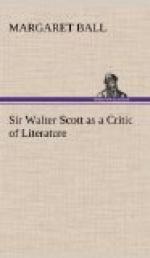The Somers Tracts
Character of the collection
and of Scott’s work on it—Occasional
carelessness—Purpose
of the notes—Scott’s attitude towards
these
studies.
While Scott was working on his Dryden and before he began the Swift he undertook to edit the great collection which had been published fifty years before as Somers’ Tracts. His task was to arrange, revise, and annotate pamphlets which represented every reign from Elizabeth to George I. He grouped them chronologically by reigns, and separated them further into sections under the headings,—Ecclesiastical, Historical, Civil, Military, Miscellaneous; he also added eighty-one pamphlets, all written before the time of James II. The largest number of additions in any one section was historical and had reference to Stafford. Among the miscellaneous tracts that he incorporated were Derrick’s Image of Ireland from a copy in the Advocates’ Library, and Gosson’s School of Abuse. Scott’s statement in the Advertisement as to why he did not omit any of the original collection shows his unpedantic attitude toward the kind of studies which he was encouraging by the republication of this series. He says: “When the variety of literary pursuits, and the fluctuation of fashionable study is considered, it may seem rash to pass a hasty sentence of exclusion, even upon the dullest and most despised of the essays which this ample collection offers to the public. There may be among the learned, even now, individuals to whom the rabbinical lore of Hugh Broughton presents more charms than the verses of Homer; and a future day may arise when tracts on chronology will bear as high a value among antiquaries as ‘Greene’s Groats’ Worth of Wit,’ or ’George Peele’s Jests,’ the present respectable objects of research and reverence.”




